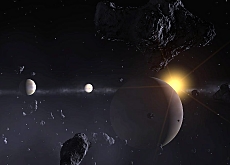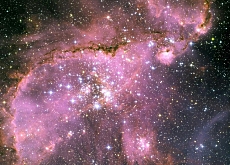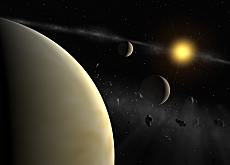Geneva astronomers spot superhot planets

Astronomers from the Geneva University Observatory have confirmed the discovery of two Jupiter-sized planets hundreds of light years away from Earth.
The pair – named Wasp-1b and Wasp-2b – were discovered using a new technique that spots planets as they move in front of their parent stars.
The planets are the first to be found during the British-led SuperWasp (Wide Angle search for Planets) programme, which repeatedly surveys millions of stars looking for tiny dips in the starlight caused when a planet passes.
Known as “hot Jupiters”, the new discoveries are around 300 times the size of the Earth. One of them – Wasp-1b – is estimated to have a surface temperature of more than 1,800 degrees Celsius.
Confirmation of the new finds came earlier this month when SuperWasp researchers joined forces with a Swiss-French team working on the powerful new Sophie spectrograph telescope at the Haute-Provence Observatory in France.
Sophie (Spectrograph for Observation of Astroseismologic Phenomenon and Extrasolar Planets) detected a slight wobble in each star’s motion as the planets orbited around them, confirming the existence and nature of the planets.
The discovery is all the more amazing since Sophie is still in the process of installation at the Haute-Provence Observatory. It is not due to be officially inaugurated until November 30.
“The old spectrograph, Elodie, died a few weeks ago and the new one was ready but is still in the process of installation,” Stéphane Udry, an astrophysicist at the Geneva University Observatory, told swissinfo.
“We used it for this project and during the first four nights we got the two planets, so we’re pretty delighted about this.”
Satellite launch
Udry said the fact that Sophie was functioning as planned boded well for the forthcoming launch of the European Space Agency’s €35 million ($44 million) Corot satellite.
This will continue the hunt for new planets from space, looking for smaller transiting planets the size of Earth.
Scientists believe they hold the key for the formation of planetary systems and an understanding of the origins of Earth. Swiss astronomists using Sophie will be involved in supplying follow-up measurements for this project.
“We are entering a new period of planet discovery,” said Udry. “The number will increase and also the kind of information we are obtaining is different. We are now down to the physical properties and the internal structure of planets.”
The SuperWasp team says it now expects to find dozens more transiting planets over the next few years in conjunction with Swiss and French astronomers.
“The partnership between the two instruments is particularly powerful. SuperWasp finds candidate planets and determines their radii, and Sophie confirms their nature and weighs them,” said Don Pollacco, the SuperWasp project scientist.
swissinfo, Adam Beaumont in Geneva
The SuperWasp has eight cameras, taking repeat images of hundreds of thousands of stars.
It has a field-of-view some 2,000 times greater than a conventional astronomical telescope.
The Sophie spectrograph telescope measures the mass and density of new planets.
The two planets were identified with the aid of the world’s biggest planet-hunting survey telescope known as SuperWasp, based on the island of La Palma in the Canaries.
The planetary nature of the discoveries was established using the Sophie spectrograph at the Haute-Provence Observatory in France.
These two telescopes have only recently begun joint operations and found the two planets in their inaugural observing seasons.

In compliance with the JTI standards
More: SWI swissinfo.ch certified by the Journalism Trust Initiative


You can find an overview of ongoing debates with our journalists here. Please join us!
If you want to start a conversation about a topic raised in this article or want to report factual errors, email us at english@swissinfo.ch.